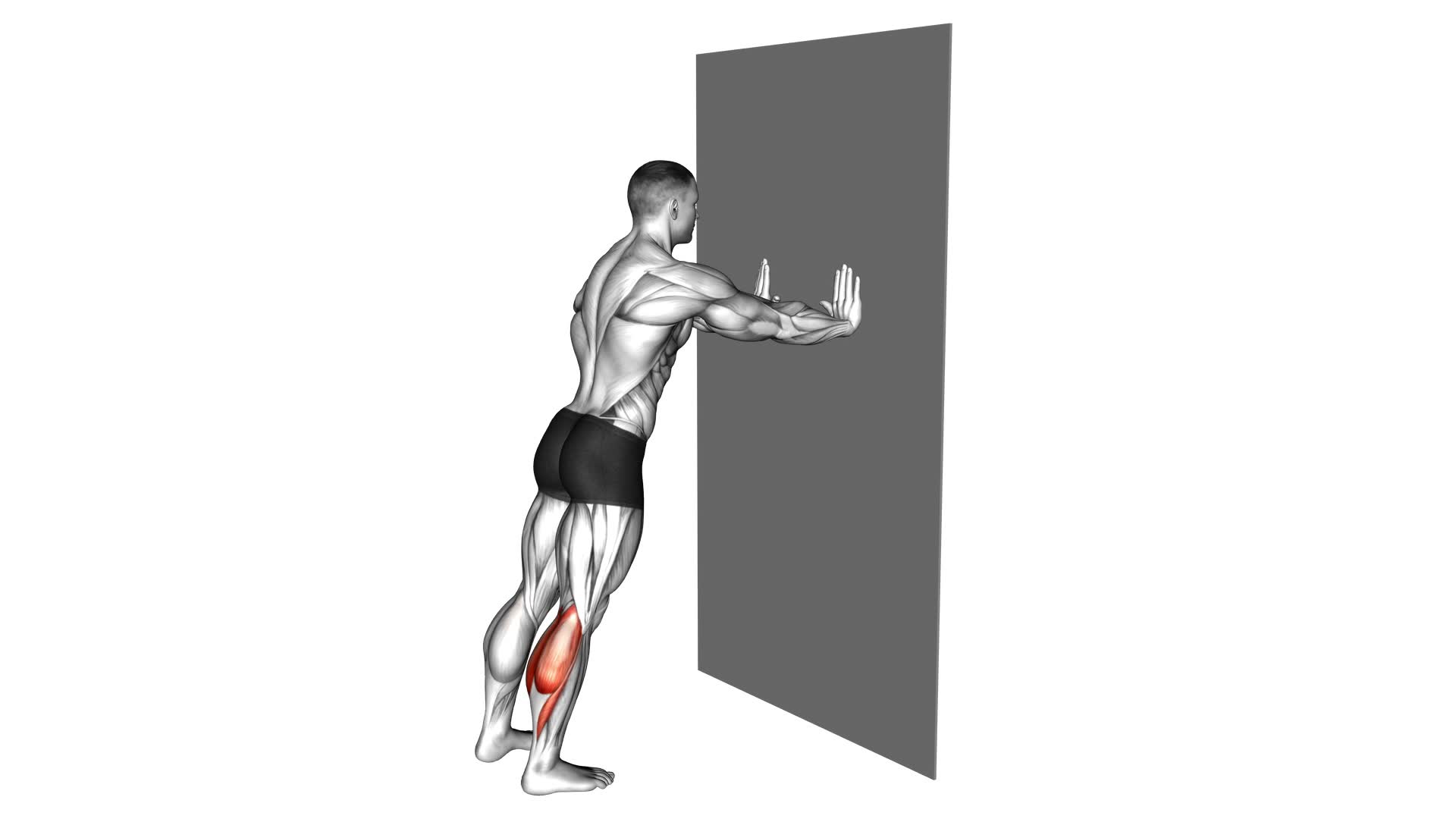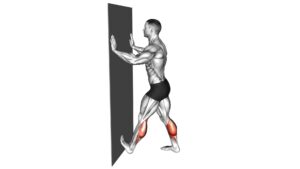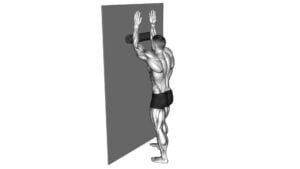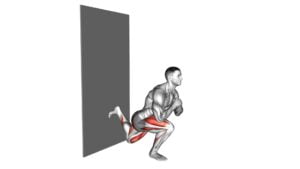Calf Stretch With Hands Against Wall – Video Exercise Guide & Tips

Looking to improve your calf flexibility and strength? Check out this video exercise guide and tips for the calf stretch with hands against the wall.
Watch This Exercise Video
You'll learn the proper technique, common mistakes to avoid, and tips for increasing intensity.
With variations and modifications, you can easily incorporate this stretch into your routine.
Get ready to feel the burn and take your calf muscles to the next level!
Key Takeaways
- The calf stretch with hands against the wall provides benefits such as improved flexibility, increased circulation, prevention of common injuries, and enhanced overall fitness.
- Proper technique for the calf stretch includes positioning feet hip-width apart, holding the stretch for at least 30 seconds, avoiding rounding the back or bouncing, keeping heels firmly on the ground, and maintaining correct foot alignment.
- The duration for optimal stretch is at least 30 seconds, balancing intensity and duration, incorporating proper stretching techniques, keeping the back straight and pressing hands against the wall, and pushing the heel towards the ground.
- Common mistakes to avoid during the calf stretch include not maintaining proper alignment, rushing through the stretch, overstretching the calf muscles, leaning too far forward, and placing feet too close to the wall.
Benefits of the Calf Stretch
You will experience numerous benefits from performing the calf stretch exercise. Incorporating calf stretches into your stretching routine offers a range of advantages that can enhance your overall fitness and prevent injuries.
One of the primary benefits of the calf stretch is improved flexibility. By regularly stretching your calf muscles, you can increase their range of motion, allowing you to move more freely and with greater ease. Additionally, calf stretch variations can target different areas of the calf, providing a more comprehensive stretch and helping to alleviate tightness or discomfort.
Another benefit of the calf stretch is improved circulation. As you stretch your calf muscles, blood flow to the area increases, delivering oxygen and nutrients to the muscles and aiding in their recovery and growth. This increased circulation can also help reduce muscle soreness and speed up the healing process.
Furthermore, the calf stretch can help prevent common injuries such as Achilles tendonitis and calf strains by strengthening and lengthening the calf muscles, making them more resilient and less prone to injury.
In summary, incorporating calf stretches into your stretching routine offers a multitude of benefits. Improved flexibility, increased circulation, and injury prevention are just a few of the advantages you can expect. By regularly performing the calf stretch, you can enhance your overall fitness and well-being.
Now, let's delve into the proper technique for the calf stretch.
Proper Technique for the Calf Stretch
To properly execute the calf stretch, the position of your feet is of utmost importance. Placing your feet hip-width apart and parallel to each other will ensure an optimal stretch.
Additionally, it's crucial to hold the stretch for at least 30 seconds to allow the muscles to fully elongate.
Lastly, be mindful of common mistakes such as rounding your back or bouncing during the stretch, as these can lead to ineffective results and potential injury.
Foot Position Importance
Position your feet correctly to ensure proper technique for the calf stretch. Proper foot alignment is crucial for maximizing the effectiveness of this exercise. Start by standing facing a wall with your hands placed against it at shoulder height. Place your feet hip-width apart, ensuring that they're parallel to each other. This alignment helps to target the calf muscles more effectively and prevents any unnecessary strain on other muscles. As you move into the stretch, keep your heels firmly on the ground and slowly lean forward, feeling a gentle stretch in your calves. By maintaining the correct foot position, you'll optimize the benefits of this stretch and avoid any potential injuries.
Now, let's discuss the duration for optimal stretch.
Duration for Optimal Stretch
For the optimal stretch in the calf stretch exercise, aim to hold the position for at least 30 seconds. This is the optimal time needed to allow the muscles in your calves to lengthen and increase flexibility. Holding the stretch for a shorter duration may not provide the desired results, while holding it for longer may lead to muscle fatigue or overstretching.
It's important to find a balance between intensity and duration to achieve the best outcomes. Additionally, incorporating proper stretching techniques can further enhance the effectiveness of the calf stretch. By keeping your back straight, pressing your hands against the wall, and pushing your heel towards the ground, you can ensure a deeper and more targeted stretch.
Now that you understand the optimal time for the calf stretch, let's move on to the next section to learn about common mistakes to avoid.
Common Mistakes to Avoid
Now that you understand the optimal time for the calf stretch, let's focus on how to perform the exercise correctly to avoid common mistakes and ensure proper technique.
Here are three common mistakes to avoid when performing the calf stretch:
- Not maintaining proper alignment: One common mistake isn't keeping your body in the correct position during the stretch. Make sure to keep your back straight, shoulders relaxed, and feet parallel to each other. This will help target the calf muscles effectively and prevent strain on other areas of the body.
- Rushing the stretch: Another mistake is rushing through the exercise. It's important to take your time and hold the stretch for at least 30 seconds on each leg. This allows the calf muscles to fully lengthen and increases the effectiveness of the stretch.
- Overstretching: Lastly, be cautious not to overstretch your calf muscles. Pushing too hard or bouncing during the stretch can lead to injury. Instead, start with a gentle stretch and gradually increase the intensity over time.
Common Mistakes to Avoid
To optimize your calf stretch with hands against the wall, be sure to avoid these common mistakes.
- Maintain correct form throughout the exercise. Many people make the mistake of leaning too far forward, which can put excessive strain on the knees and diminish the effectiveness of the stretch. To avoid this, keep your back straight and engage your core muscles to support your body.
- Avoid rushing through the stretch. Take your time and hold the position for at least 30 seconds to allow the muscles to properly lengthen and relax.
- Be mindful of your foot placement. Placing your feet too close to the wall can limit the range of motion and limit the stretch. Instead, step back slightly to ensure a full stretch of the calf muscles.
By avoiding these mistakes and maintaining correct form, you can maximize the benefits of the calf stretch.
Now, let's move on to some tips for increasing the intensity of this exercise.
Tips for Increasing Intensity
To amp up the difficulty of your calf stretch with hands against the wall, try incorporating these tips for increasing intensity:
- Increase the lean: Instead of keeping your body upright, lean forward more while performing the calf stretch. This will intensify the stretch in your calf muscles and provide a greater challenge. Make sure to maintain proper form and keep your heels firmly on the ground.
- Add resistance: Hold a dumbbell or a weighted object in your hands while performing the calf stretch. The added weight will increase the resistance and further engage your calf muscles. Start with a lighter weight and gradually increase as you become more comfortable.
- Single-leg variation: Instead of stretching both calves at the same time, try the calf stretch with one leg at a time. This advanced technique will increase the difficulty and demand more stability and strength from your calf muscles. Remember to switch sides and perform an equal number of repetitions for each leg.
Incorporating these advanced techniques will challenge your calf muscles even more and help you progress in your flexibility and strength goals. Remember to listen to your body and only push yourself to a level that feels comfortable and safe.
Variations and Modifications
If you want to modify the calf stretch with hands against the wall, you can try different variations to target specific areas of the calf muscles. One modification is to perform the stretch with one leg at a time. Simply step one foot forward and place your hands on the wall at shoulder height. Keep your back leg straight and your heel on the ground. Lean forward until you feel a stretch in the calf of your back leg. Hold for 30 seconds and then switch legs.
Another modification is to perform the stretch with a bent knee. Instead of keeping your back leg straight, bend the knee slightly. This variation targets the soleus muscle, which is deeper in the calf.
For those looking for more advanced techniques, you can try performing the stretch on an elevated surface, such as a step or a curb. This increases the stretch and allows for a greater range of motion.
Incorporating these modifications and advanced techniques into your calf stretching routine can help you target specific areas of the calf muscles and improve flexibility.
Now, let's move on to the next section and discuss how to incorporate the calf stretch into your routine.
Incorporating the Calf Stretch Into Your Routine
To incorporate the calf stretch into your routine, start by finding a wall or sturdy surface to lean against. This stretch is a great addition to your stretching routine, as it specifically targets the muscles in your calves, helping to improve flexibility and prevent injuries.
Here are three ways you can incorporate the calf stretch into your routine:
- Pre-workout warm-up: Before you begin your regular workout routine, take a few minutes to stretch your calves. This will help to warm up the muscles and prepare them for the upcoming exercises. Start by standing facing the wall with your hands on the wall at shoulder height. Step one foot back, keeping the heel on the ground, and bend the front knee. Lean forward into the wall until you feel a stretch in your calf. Hold for 30 seconds and then switch sides.
- Post-workout cooldown: After you finish your workout, it's important to cool down and stretch your muscles. Incorporating the calf stretch into your cooldown routine can help to prevent muscle tightness and soreness. Follow the same steps as mentioned above, but hold the stretch for a longer duration, around 60 seconds per side.
- Daily stretching routine: Even on days when you're not working out, it's beneficial to stretch your calves. Consider incorporating the calf stretch into your daily routine, such as in the morning or before bed. This will help to maintain flexibility and prevent muscle imbalances.
Frequently Asked Questions
How Long Should I Hold the Calf Stretch For?
When it comes to calf stretches, it's important to hold the stretch for an adequate amount of time to reap the benefits. The duration varies depending on your fitness level and flexibility. Generally, holding the calf stretch for 20-30 seconds is a good starting point. This allows the muscles to lengthen and improve flexibility.
However, if you're more advanced, you can hold it for longer. It's also worth exploring different variations of the calf stretch to target different muscles and challenge your body.
Can I Do the Calf Stretch if I Have a Previous Calf Injury?
If you have a previous calf injury, it's important to be cautious when doing the calf stretch.
It's always best to consult with a healthcare professional or physical therapist before attempting any exercises. They can provide you with specific modifications or alternative calf stretches that will be safe and effective for your condition.
Is It Normal to Feel Discomfort or Pain During the Calf Stretch?
Feeling discomfort or pain during the calf stretch isn't normal and could be a sign of improper form or an underlying issue.
When performing the stretch, make sure to maintain proper alignment and avoid overstretching.
If you experience discomfort, it's important to modify the calf stretch or try alternative exercises that target the calf muscles.
Always listen to your body and consult with a healthcare professional if you have any concerns or previous calf injuries.
Can I Do the Calf Stretch Without a Wall?
Yes, you can do the calf stretch without a wall. There are alternative stretches you can try if you don't have access to a wall.
One option is to use a step or curb to elevate your heel and stretch your calf.
Another modification for the calf stretch is to sit on the floor and use a towel or resistance band to pull your toes towards you.
These modifications can provide a similar stretch to the calf muscles.
Are There Any Precautions I Should Take Before Attempting the Calf Stretch?
Before attempting the calf stretch, it's important to consider a few precautions. First, make sure you're wearing supportive shoes to avoid any strain on your feet.
Secondly, warm up your muscles with some light cardio to prevent any injuries.
Lastly, listen to your body and don't push yourself too hard.
Now, let's talk about the benefits of this stretch. It helps improve flexibility in your calf muscles, reduces tightness, and can even alleviate muscle cramps.
Conclusion
Incorporating the calf stretch into your routine can provide numerous benefits, such as improved flexibility and reduced risk of injury.
By following the proper technique and avoiding common mistakes, you can effectively stretch your calves and increase the intensity over time.
With variations and modifications available, you can personalize the exercise to suit your needs.
Make sure to consult with a fitness professional if you have any concerns or specific goals in mind.
Start incorporating the calf stretch into your routine today for stronger and more flexible calves.

Author
Years ago, the spark of my life’s passion ignited in my mind the moment I stepped into the local gym for the first time. The inaugural bead of perspiration, the initial endeavor, the very first surge of endorphins, and a sense of pride that washed over me post-workout marked the beginning of my deep-seated interest in strength sports, fitness, and sports nutrition. This very curiosity blossomed rapidly into a profound fascination, propelling me to earn a Master’s degree in Physical Education from the Academy of Physical Education in Krakow, followed by a Sports Manager diploma from the Jagiellonian University. My journey of growth led me to gain more specialized qualifications, such as being a certified personal trainer with a focus on sports dietetics, a lifeguard, and an instructor for wellness and corrective gymnastics. Theoretical knowledge paired seamlessly with practical experience, reinforcing my belief that the transformation of individuals under my guidance was also a reflection of my personal growth. This belief holds true even today. Each day, I strive to push the boundaries and explore new realms. These realms gently elevate me to greater heights. The unique combination of passion for my field and the continuous quest for growth fuels my drive to break new ground.







